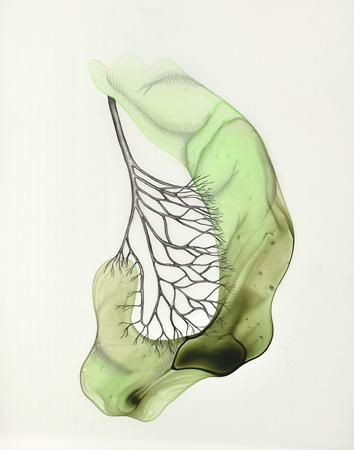
In the past few months I have been working on another variety of the Pareidolia series, one in which I am focusing on interactions between humans and other species. I began the first two pieces partly in response to my experiences at the ChaNorth residency this past summer, and partly as a result of reading The Wild Life of Our Bodies which describes life with parasites, mutualists, and pathogens. I began thinking about crops vs. weeds, biofilm, and bacteria that outnumber our own cells and influence our behavior while breaking down nutrients and helping us digest food.
It all started at the ChaNorth residency where the artists participated in a farming internship. We spent a few hours per week on the McEnroe farm – weeding, harvesting, and learning about farming. My experience on the farm was an unexpected one; I found myself weeding the same varieties of plants that I spent carefully observing and drawing for a couple of weeks prior to the residency. This shift in disposition sparked an emotional response; I began researching weeds and plants in general.
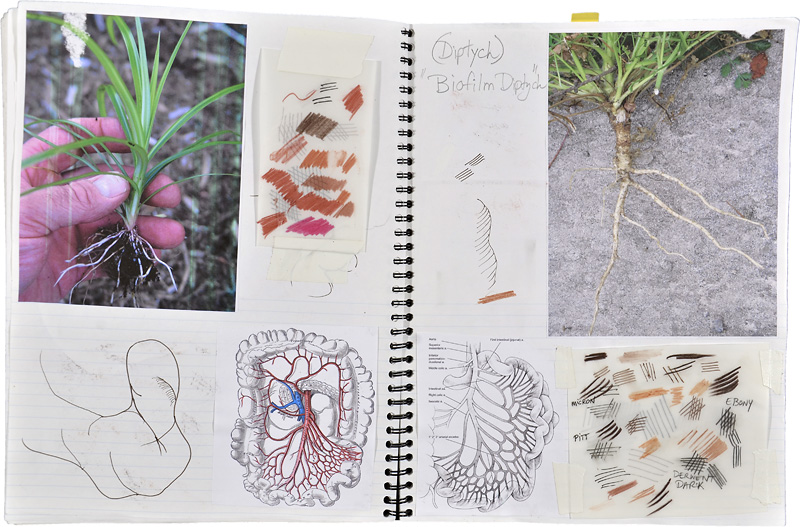
A description of biofilm immediately caught my interest: it is a layer of bacterial slime that coats plant roots and protects them from harmful organisms while simultaneously making nutrients more accessible. What struck me is just how similar this biofilm is to the one we have in our digestive tracts, despite the vast difference in organisms. I decided to create a drawing (above) vague enough that it could double as both a plant root and an intestine. I already had two experimental sheets of translucent polypropylene with appropriately colored inkblots. They reminded me of plants and flesh, so I chose these two for a pair of drawings that combined images of intestines and plant roots. I thought I was going to keep them both, but the green one worked out better with a vaguely intestinal/plantlike look. Since I was toying with intestines, another experiment involved filling an entire watercolor page with an image of a colorful intestine without leaving any white of the paper. The finished painting didn’t do much for me…
But the next piece was a breakthrough of sorts. I took one of my symmetrical inkblots (a faint blue mirror image on two sheets of paper) and turned it upside down. The upward-bound, vertical drip lines on these two sheets of paper reminded me of plants growing from the ground, and I imagined a whole scenario with corn, weeds, and organs. I decided to keep the ethereal quality of the pale blue ink by using only graphite as a drawing medium on the outskirts of the ink. To my astonishment, I found an image of a maize crop that perfectly matched one of the peripheral shapes in the ink. This lucky coincidence snowballed the rest of the drawing, which I describe on this page in my sketchbook.
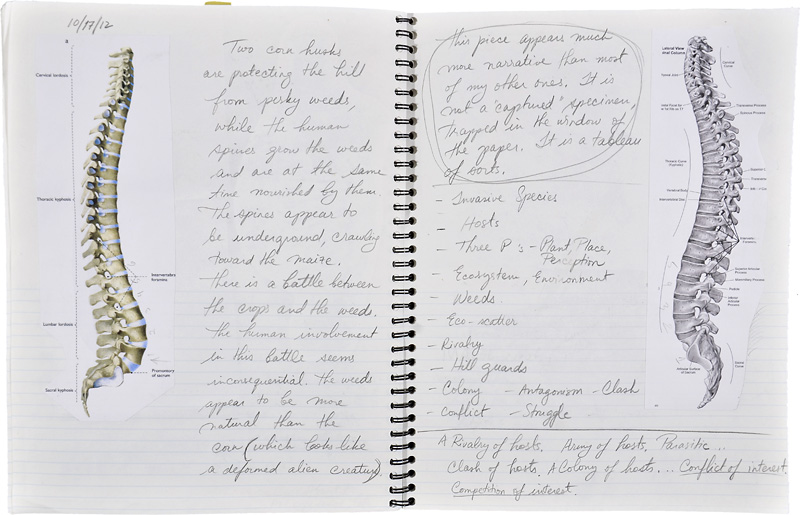
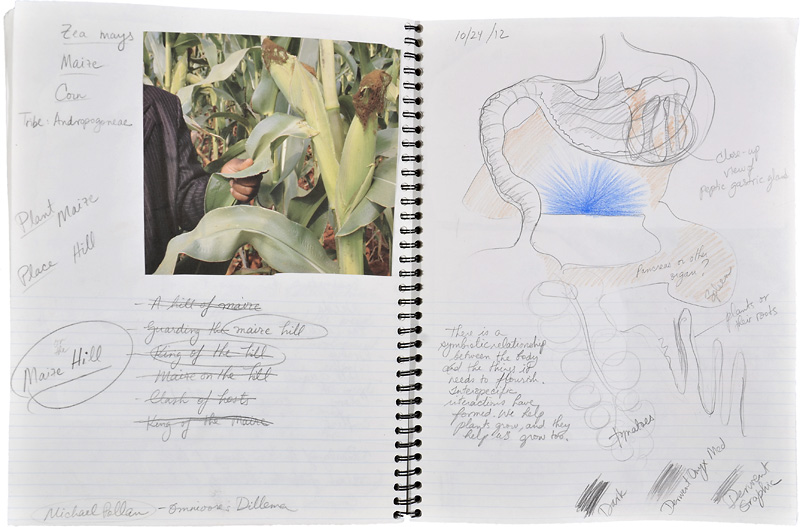
After beginning this drawing, I returned to Chicago and wrapped up a bunch of other projects and responsibilities before I resumed this series. Approaching these ideas with fresh eyes, I decided to draw a relatively elaborate digestive tract with a tomato vine growing inside it, among other things. I was thinking of human mutualism with the plants that we have domesticated and as a result changed. These plants, in turn, permanently changed us: our bodily make-up, our dietary needs, and our lifestyles.
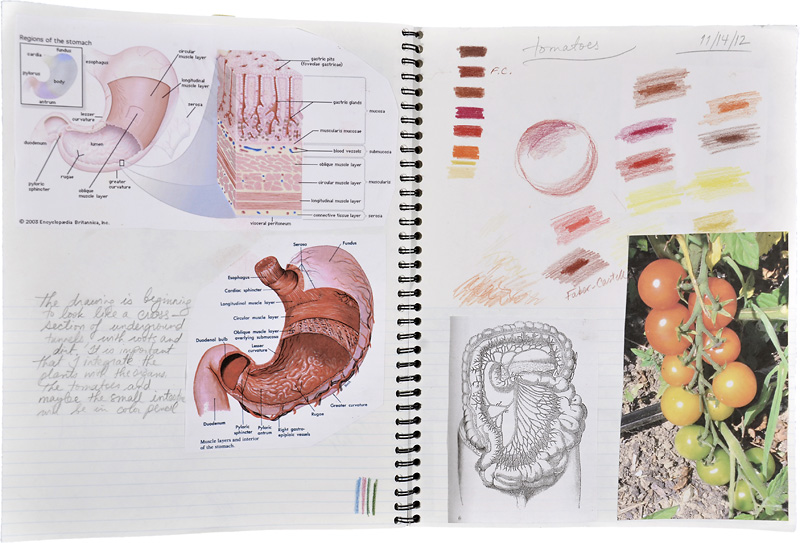
Tomatoes are the staple plant of the McEnroe farm, so I was able to shoot some really nice reference photos of tomato vines over the summer. Maybe it’s just me, but the tomato vine (in the image on the right) looks strangely similar to intestinal blood vessels. It was difficult to start this drawing; I knew that I wanted to incorporate tomatoes (the original inkblot already had a couple of red spots in it) and internal organs, but I struggled with the starting point. Once I visualized the stomach crossing over the ink into the negative space, the rest fell into place. In contrast to the carefully rendered bright red tomatoes in colored pencil, I made references to 19th century monochromatic medical illustrations. I also omitted green in order to blend the imagery. The finished drawing is unusual for my work. With cream-colored paper and tight rendering, it has more of an antique aesthetic than the rest of my artwork.
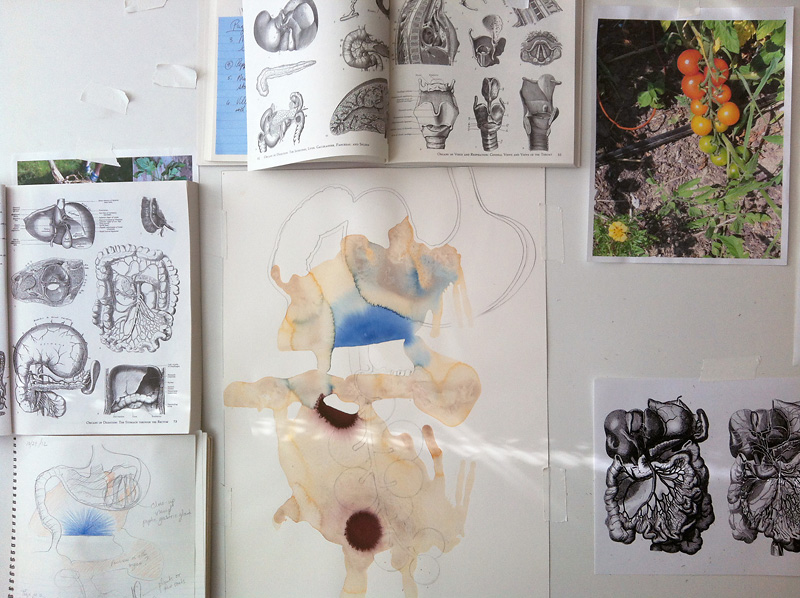
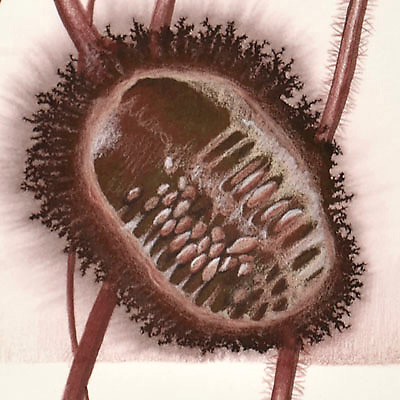
Shortly after I finished this piece, a friend and I discussed anatomical hearts as subject matter. She asked why I was so drawn to the heart. I expressed my continued struggle; I feel conflicted as I find the anatomical heart both structurally interesting and a cliché. In any case, I keep drawing it. What is it about the heart over other organs? I think my interest is multifaceted. Although the symbolism will always be there, I think I am drawn to its structural qualities. It is a complex organ with delineated chambers. Unlike the bladder, which is more of a pouch, or the liver, which is rather solid and meaty, the heart is a container with symmetry and definition, both vessel-like and architectural. I looked at one of my inkblots and saw a form that looked both fruit- and heart-like. This lead to a drawing that I ended up cropping into smaller and smaller portions due to my displeasure with the unresolved background and the lack of anatomical resemblance to a heart. I was hoping to experience a vague merging of the two images (heart and fruit), but the drawing turned out pod-like. Here is what’s left.
The latest drawing excited me most. I think I still had the image of the tomato vines somewhere in my head when I began this piece. I was also looking at numerous old illustrations of intestines. I observed the following colorful inkblot on my studio wall and began envisioning a large intestine surrounding an unfurling small intestine. The resemblance of the ink to some of the line drawings of intestinal blood vessels from the 19th Century (see sketchbook images above) seemed uncanny to me at the time, which was all I needed to get started. Having recently finished the tomato drawing with intestines, I decided to try some new stuff with this one.
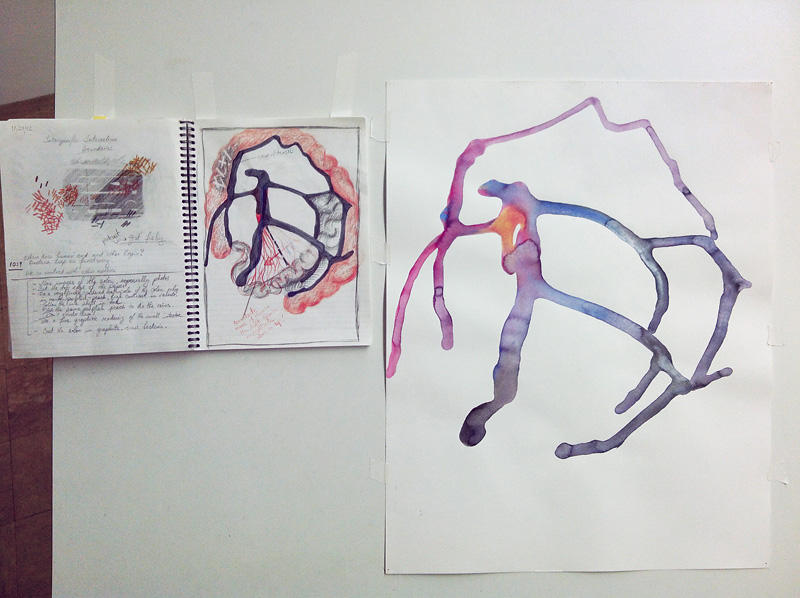
About a year ago, I had heard two unrelated podcasts. One was a Science Friday interview with Rob Dunn in which he talked about his book. He mentioned that beneficial bacteria outnumber our own cells in our bodies. The other podcast was a Radiolab episode about the effects of bacteria on our emotional states and behavior, the “gut feeling” as a literal phenomenon. Having heard these two podcasts in close succession, a startling thought came over me: ontologically, we might be more of a bacterial creature than we think.
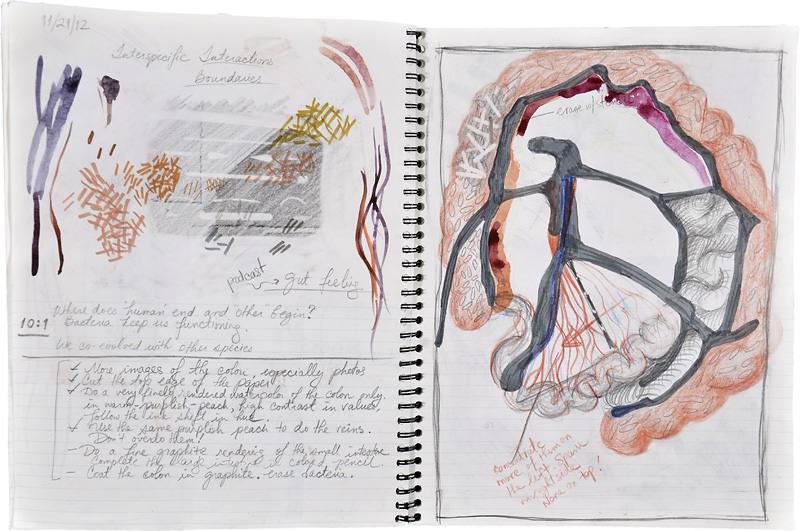
I decided to make a portrait of the bacteria in their environment. At this point, I was listening to strange episodes of the Moth while trying out various new drawing techniques. I wanted the bacteria to look like images from a microscope: transparent and ethereal. My association of gut bacteria with yogurt may have influenced this aesthetic as well. I remembered that I had one of those drafting eraser shields. My solution was to coat the paper with graphite, and then erase lots of little bacterial shapes.
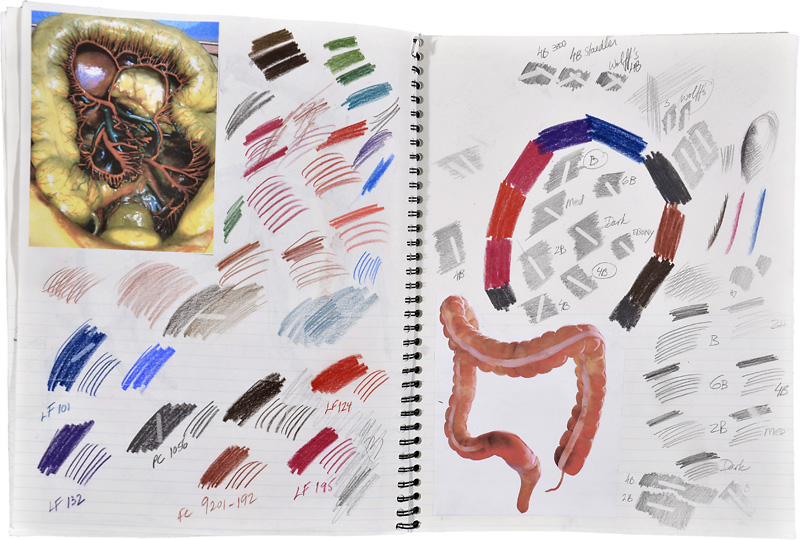
I have a few more things planned for this series. After that, I might jump back to some new work on the architectural series. I am also thinking about getting a hold of some really large roll paper and scaling up to see what happens, maybe even with reference images obtained via microscope. The microscope idea became incontestable after I saw this awesome video.
am finally reading this post…i also read Rob Dunns books, great writer… first the one about the hunt for species and the Wild Bodies, which also gave me art ideas for sculptural pieces…
reading about ypur process is interesting and i loved the drawings i saw in your studio last feedback loop…